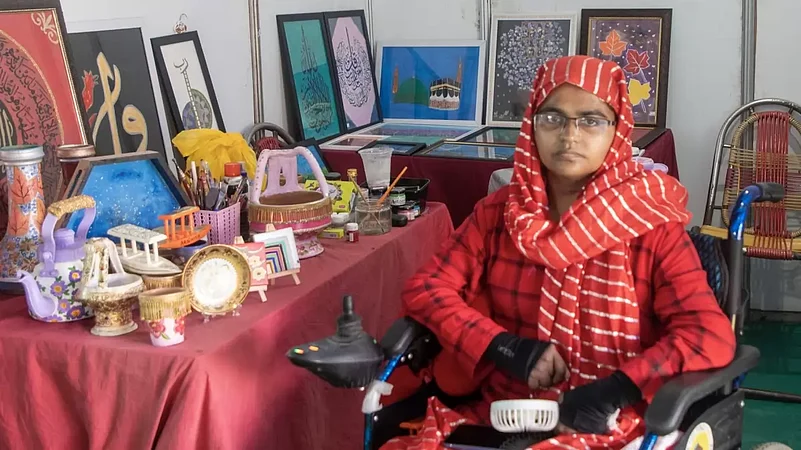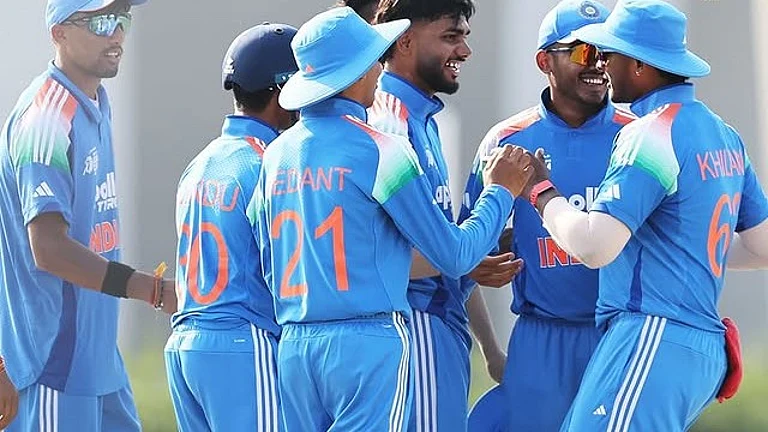At the Kashmir Haat festival in Srinagar, only a few customers stop at the calligraphy stall. They approach a bespectacled woman, who is in a wheelchair, to inquire about the prices of her handwriting art pieces, then talk to her about her life and then move on without buying anything.
"No one appears to be interested in buying anything," says the woman, who goes by the name Saima Noor. Saima Noor is not her real name. She was given different names throughout her life, but she eventually settled on Saima Noor. Born in Karnataka, Saima was a four-year-old girl when she went missing in Bangalore streets one day.
"For three days, I wandered on the roads of Bangalore. Then on the fourth day, a woman came to me. She consoled me when I told her I had no idea about the whereabouts of my parents," says Saima, recalling those turbulent childhood days. “My father was a chokidar. We were three sisters and one adopted brother. I remember my father would call me Noor. That is all,” she says.
The woman, who was working as a housemaid with a Kashmiri family, took Noor to the Kashmiri family. “She told me you will be safe with this Kashmiri family and it all proved true,” she adds.
Saima stayed with the Kashmiri family. They advertised her missing status, but no one came forward. She remained with the family, and after a few years, they sent her to live with a family friend to take care of their only child. "I was sent as a caretaker," she says. For the next twenty years, Saima remained with this family in Srinagar.
Life was going on smoothly for her and she had no complaint. She had learned Kashmiri and was speaking it fluently.
Her world, however, changed in 2010.
That year, she felt pain beneath her feet. She presumed it was gout and she stopped eating meat. However, the pain persisted. The family took her to an orthopedic doctor who initially diagnosed her with knee pain. The doctor provided her with medication, which helped for some time, but the pain returned. In 2014, the pain had become unbearable and doctors recommended hip replacement. She underwent hip replacement surgery in Srinagar. Saima says the family who had adopted her for work, did everything within their means to support her medical bills and other expenses, amounting to around 5 lakh rupees.
But after the operation, she found herself unable to do any work. "My bones started weakening, and it became difficult for me even to walk." The family provided her with an anteroom to stay.
In April 2018, she thought this static life would kill her. She went to the SMHS hospital in Srinagar for treatment. There she met Dr Abdul Khaliq, a well-known rheumatologist. "He is a great human being," says Saima.
She says the good doctor heard her and admitted her to ward six of the SMHS hospital. She says Dr Khaliq treated her for some time and then realized that she shouldn't remain away from the hospital. On Dr Khaliq's recommendation, Noor was allowed to have a room adjacent to ward six. After Dr Khaliq's retirement, the hospital administration asked her to leave, but other staff members intervened, stating that she had nowhere to go. She also received an order from deputy commissioner Srinagar’s office allowing her to stay in the hospital.
During her time at the hospital, one of the staff members motivated her towards drawing, and gradually, she started doing calligraphy. It all started in 2019.
"I am illiterate and I did not know anything. But I was craving to do some work. I started enjoying calligraphic art. It has letters and colours, and it is closer to my heart. Once I am drawing, I am oblivion to the pain and noise around the hospital," she says. “It also made me self-sufficient. At least I can afford a day's meals through my art.”
Saima has a strong desire to have a permanent space somewhere in Srinagar.
"My day starts with having tea in the morning and then I don’t eat much. I am alive because of the people around me in the hospital. They change my catheter in the morning and put me on the wheelchair, allowing me to go anywhere to get colours and frames and also inquire about my well-being by calling me on my phone," she says. “That is my life and these are people in my life.”
Her only complaint is that people in Kashmir don't buy much calligraphic art. "They love it, they appreciate it, and they also want to hear my story but they don’t buy much. I am not the only one complaining; other artists would say the same thing," she says laughing.


























